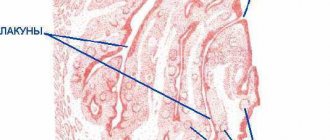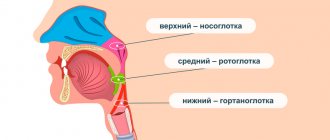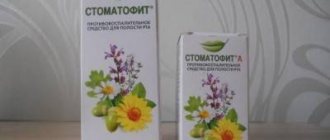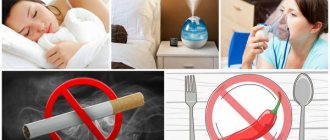12/21/2021
182 959
7 minutes
Author, editor and medical expert – Klimovich Elina Valerievna.
Editor and medical expert – Harutyunyan Mariam Harutyunovna.
Fever with sore throat (acute tonsillitis) is the same characteristic symptom as a sore throat. But sometimes the temperature is high, and the sore throat is not very pronounced1. Because of this, people do not treat the disease, but simply try to “bring down” the temperature - this is unsafe1,3. What determines the temperature level during tonsillitis, and what needs to be done to alleviate the condition?
Before finding out what temperature happens with a sore throat, you need to figure out what is considered a normal temperature and what is not.
In children and adults, the morning temperature measured in the armpit should be less than 37.20C2. In the evening, the temperature is allowed to rise to 37.70C - this is normal, especially for children2. Anything higher is considered to be fever2.
Up to contents
Symptoms of acute tracheitis
Acute tracheitis is manifested primarily by attacks of coughing - dry, painful, quite rough and intrusive. It intensifies at night and in the morning, which is associated with the accumulation of sputum in the respiratory tract. A coughing attack during tracheitis can also be provoked by other factors: laughter, screaming, deep breaths, contrasting air temperature, strong aromas and smoke. In the first days, sputum is hardly formed or remains so viscous that it is difficult to pass away. Therefore, at the beginning of the disease, the cough is dry, annoying, and does not bring relief. As tracheitis develops and when the bronchi are involved in the inflammatory process, sputum production increases and it becomes thinner. At the same time, the cough becomes moist, more productive and less exhausting, and its attacks are repeated less frequently. The patient's well-being improves significantly.
In addition to cough, other symptoms of acute tracheitis are often observed:
- pain, a feeling of rawness and burning behind the sternum, especially pronounced after another coughing attack;
- changes in the frequency and depth of breathing;
- increased body temperature (usually up to 38°C), which is typical mainly for infectious and complicated tracheitis;
- headache;
- general weakness, fatigue, fatigue and other signs of general intoxication.
It is important to know!
The inflammatory process with tracheitis often spreads to neighboring areas of the respiratory system, because there is no clear boundary between them, the mucous membrane smoothly passes from one part of the respiratory tract to another. The drainage of sputum or its upward movement when coughing contributes to tissue irritation and the spread of the pathogen. When the bronchi are involved in inflammation, tracheobronchitis develops. This is accompanied by a deterioration in the patient’s condition: his body temperature rises, coughing attacks become more frequent, chest pain becomes stronger, shortness of breath may appear. If tracheitis is accompanied by laryngitis, you need to be prepared for hoarseness or even temporary loss of voice. And with accompanying swelling of the subglottic space of the larynx (it is located approximately under the vocal cords), acute respiratory failure may develop with difficulty inhaling and a feeling of fear.
Literature
- Delyagin V. M. Fever (new touches on an ancient picture) // Pediatrics. Consilium Medicum. - 2022. - No. 2. — pp. 89-93
- Belan Yu. B., Starikovich M. V. Fever in pediatric practice // Attending physician. - 2022. - No. 1. — P. 40-43.
- Krasnova E.I., Khokhlova N.I., Provorova V.P., Evstropov A.N. Differential diagnosis and therapeutic tactics for acute tonsillitis (tonsillitis) at the present stage // Attending physician. - 2022. - No. 11. - P. 58-63.
- Instructions for use of the drug HEXORAL® solution.
- Instructions for use of the drug HEXORAL® aerosol.
- Instructions for use of the drug HEXORAL®TABS.
- Instructions for use of the drug HEXORAL®CLASSIC.
- Instructions for use of the drug HEXORAL®TABS EXTRA.
Up to contents
come back
Why does acute tracheitis occur?
Infection
The development of the disease is most often caused by viral infections - influenza and other viruses that affect the respiratory tract and respiratory system. Bacteria can also be causative agents: pneumo-, strepto-, staphylococci and others. Often there is a so-called mixed infection, when inflammation is caused by several different pathogens at once. In this case, most often the bacterial infection is secondary; it complicates the course of ARVI.
Non-infectious factors
Acute tracheitis in an adult can also be non-infectious in nature, although this is less common.
- Mechanical injuries
. Traumatic tracheitis is possible when foreign bodies enter the respiratory tract, for example, as a result of insufficiently careful endoscopic examination of the bronchial system and tracheal intubation during surgical anesthesia.
- Thermal effects - inhalation of cold or (less often) very dry hot air
. In this case, the key point in the development of inflammation is not irritation of the walls of the trachea, but the vascular spasm that occurs in them. This leads to disruption of the functioning of the glands in the walls of the trachea and a decrease in the protective function of its mucous membrane.
- Chemical burns that occur when inhaling fumes from alkaline or acidic products
. These can be aggressive household chemicals, industrial waste, paint and varnish products, petroleum products, chemical reagents. This type of tracheitis is especially difficult.
- Irritation of the mucous membrane of the respiratory tract by polluted, dusty or excessively dry air
. Tobacco smoke, including passive smoking, is of particular importance.
- An allergic reaction in response to the entry of individually significant allergens into the respiratory tract
. In this case, tracheitis is usually combined with laryngitis, obstructive bronchitis (complete obstruction of the bronchial tubes) or even pulmonary edema.
Sometimes tracheitis becomes an occupational disease, that is, its occurrence is associated with harmful factors at work. Therefore, workers in hot shops, farms, chemical and oil refineries, as well as miners and stonemasons are at risk.
Should I lower the temperature or not?
There is no need to rush to lower the temperature. First of all, the patient must be examined by a doctor. You should follow the doctor’s recommendations: if he advises you to lower your temperature, then you should lower it. The doctor makes decisions based on the general picture of the disease and assessment of the patient’s condition, that is, recommendations are always individual.
However, if the patient has a severe fever and the temperature is high (39°C or higher), then he can be given an antipyretic drug, strictly following the instructions on the package. At the same time, you need to understand that you are fighting a symptom, not a disease.
The correct course of treatment involves identifying the cause of the high temperature and carrying out a set of measures aimed at treating the disease that caused its increase.
What contributes to the development of tracheitis?
Tracheitis does not develop in all people who have an acute respiratory viral infection, have been in contact with irritating substances, or have been frozen. The risk of tracheal damage increases in the presence of predisposing factors. First of all, these are any background diseases of the upper respiratory tract, accompanied by impaired nasal breathing. A runny nose of any nature, sinusitis, severe curvature of the nasal septum lead to the fact that a person begins to breathe through the mouth. As a result, insufficiently warmed and humidified air enters the larynx and trachea, which irritates the mucous membrane and increases the risk of inflammation during infection. Predisposing factors include heart disease, accompanied by chronic heart failure with stagnation in the pulmonary circulation. The resulting swelling of the mucous membrane leads to a decrease in its barrier function. Lack of vitamins and nutrients, decreased immunity, excess toxins in the body - all this also increases the risk of inflammation of the trachea in response to the introduction of a pathogen or hypothermia.
Signs of a high fever
The following signs (symptoms) may indicate that the temperature is rising:
- a feeling of weakness, sudden fatigue, a general painful state;
- chills (mild chills at slightly elevated temperatures and severe chills at high temperatures);
- dry skin and lips;
- headache, body aches;
- loss of appetite;
- sweating (“breaks into a sweat”);
- arrhythmia.
If you are experiencing any of these symptoms, it would be a good idea to take a thermometer.
Treatment of acute tracheitis
Acute tracheitis must be treated under the supervision of a specialist. In some cases, additional examination is required to clarify the cause and nature of the disease.
The main objectives are:
- impact on the cause of the disease. This includes stopping an allergic reaction, eliminating an infection, removing a foreign body, avoiding the action of provoking factors;
- relief of coughing, transformation of a dry cough into a wet one;
- reducing the severity of inflammation;
- elimination of background and aggravating conditions of tracheitis: lack of vitamins, exhaustion, weakened immunity;
- reducing the severity of intoxication and (if necessary) lowering body temperature. It is important to remember that fever is a natural mechanism to fight infection. Therefore, you should not abuse antipyretics. They can improve your well-being, but do not affect the course of the disease.
Uncomplicated forms of tracheitis can be treated on an outpatient basis. But severe cases of the disease may require hospitalization. Particular attention is paid to the treatment of weakened and elderly patients, especially if they are unable to move independently for health reasons, because tracheitis in them quite easily turns into tracheobronchitis and even pneumonia. Treatment is carried out comprehensively, using medications and non-drug methods. You should not interrupt therapy after the condition improves; you must follow the time limits for taking medications recommended by your doctor.
Drug treatment of tracheitis
The drug treatment regimen for acute tracheitis is drawn up taking into account the nature of the disease and the severity of the patient’s symptoms.
Impact on the cause
If the causative agent is a particular virus, antiviral agents are usually used, as well as immunostimulants (for example, preparations based on echinacea). For severe and protracted tracheitis of a bacterial nature, the doctor may introduce antibiotics into the treatment regimen. If the disease proceeds without complications, it is usually possible to cope with it without these remedies. But the decision on the rationality and duration of antibiotic therapy should be made only by a doctor. In some cases, with tracheitis, a bacteriological examination of sputum is carried out before starting treatment with antimicrobial agents. It is sown on nutrient media to determine the type of pathogen and its sensitivity to the main groups of drugs. This will help you choose the most suitable antibiotic.
Treating coughs and clearing the airways
When treating acute tracheitis, great attention should be paid, of course, to cough, the main symptom of the disease. For a dry, debilitating, nonproductive cough, medications that suppress the cough reflex are used. This measure may be necessary in the first days of tracheitis. At the next stage of the disease, the main goal of treatment is to clear the airways of the mucus that forms. To do this, it is necessary to facilitate its passage with the help of mucolytic and expectorant agents. But they cannot be used simultaneously with antitussive drugs. It is also unacceptable to suppress a wet cough. This is fraught with stagnation of sputum and the transition of inflammation to the underlying parts of the respiratory system, up to the development of bronchopneumonia.
Maintenance therapy
Herbal remedies may be helpful to relieve the symptoms of tracheitis. For tracheitis, they can be used in the form of decoctions and infusions. But a more convenient and reliable method of treatment is the use of ready-made herbal products with a carefully selected and balanced composition. For example, in a complex treatment regimen for tracheitis, you can include Doctor MOM® cough syrup, which contains extracts of licorice, elecampane, Vasiki adatodes, Indian nightshade and other medicinal plants - 10 medicinal plants in total. It is suitable for both adults and children over 3 years old. This remedy helps thin mucus and helps remove it from the respiratory tract, and also relieves inflammation. For adults, there are also herbal cough lozenges Doctor MOM® based on extracts of licorice, ginger and Emblica officinalis. They also soften coughs and have anti-inflammatory and expectorant effects. Such lozenges can be used as an aid in the treatment of tracheitis. They help cope with coughing attacks and ease the course of the disease.
General tips on how to help the body cope with illness
For any disease of the respiratory tract, including tracheitis, you should follow some simple rules.
- Drink more warm liquids: fruit drinks and heated mineral water without carbon, decoctions of rose hips, raspberries and linden blossoms. This will not only help relieve intoxication, but will also help thin the sputum.
- Eat high-calorie, vitamin-rich foods. During illness, the body needs nutrients to repair tissue and maintain the functioning of the immune system.
- Stop smoking and ask family members to smoke only outside the home.
- Eliminate irritating factors: smoke, dust, strong odors. During illness, it is advisable not to use household chemicals and temporarily stop using perfumes and eau de toilette.
- Ventilate the room and maintain a sufficient level of humidity. Dry air irritates the mucous membrane of the respiratory tract and provokes coughing attacks.
With timely treatment, tracheitis resolves within 10–14 days, without leaving any consequences and without subsequently limiting the ability to work.











